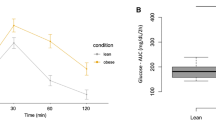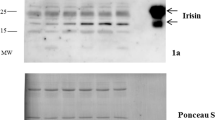Abstract
OBJECTIVE: The role of α-melanocyte stimulating hormone (MSH) in obesity has been well-documented. However, circulating α-MSH concentrations in obese men and their relationship with clinical indicators of obesity and glucose metabolism have not as yet been evaluated.
METHODS: We measured the plasma concentrations of α-MSH in 15 obese and 15 non-obese male subjects. The relationship of the plasma concentrations of α-MSH with body mass index (BMI), body fat mass (measured by bioelectric impedance), body fat distribution (measured by computed tomography), insulin levels, insulin resistance (assessed by the glucose infusion rate (GIR) during an euglycemic hyperinsulinemic clamp study) and with the serum concentrations of leptin and TNF-α were also evaluated.
RESULTS: In obese men, the plasma α-MSH concentrations were significantly increased compared with those in non-obese men (P<0.02). The plasma levels of α-MSH were positively correlated with BMI (r=0.560, P<0.05), fasting insulin levels (r=0.528, P<0.05) and with visceral fat area (r=0.716, P<0.01), but negatively correlated with GIR (r=−0.625, P<0.02) in obese male subjects. There were significant correlations between plasma concentrations of α-MSH and visceral fat area (r=0.631, P<0.02), and GIR (r=−0.549, P<0.05) in non-obese male subjects. Circulating concentrations of α-MSH were not significantly correlated with the serum concentrations of leptin and TNF-α in both obese and non-obese men.
CONCLUSION: Circulating concentrations of α-MSH are significantly increased and correlated with insulin resistance in obese men.
This is a preview of subscription content, access via your institution
Access options
Subscribe to this journal
Receive 12 print issues and online access
$259.00 per year
only $21.58 per issue
Buy this article
- Purchase on Springer Link
- Instant access to full article PDF
Prices may be subject to local taxes which are calculated during checkout




Similar content being viewed by others
References
Kalra SP, Dube MG, Pu S, Xu B, Horvath TL, Kalra PS . Interacting appetite-regulating pathways in the hypothalamic regulation of body weight Endocr Rev 1999 20: 68–100.
Marsh DJ, Hollopeter G, Huszar D, Laufer R, Yagaloff KA, Fisher SL, Burn P, Palmiter RD . Responce of melanocortin-4 receptor-deficient mice to anorectic and orexigenic peptides Nature Genet 1999 21: 119–122.
Gu W, Tu Z, Kleyn PW, Kissebah A, Duprat L, Lee J, Chin W, Maruti S, Deng N, Fisher SL, Franco LS, Burn P, Yagaloff KA, Nathan J, Heymsfield S, Albu J, Pi-Sunyer FX, Allison DB . Identification and functional analysis of novel human melanocortin-4 receptor variants Diabetes 1999 48: 635–639.
Shimizu H, Tanaka Y, Sato N, Mori M . α-melanocyte-stimulating hormone (MSH) inhibits insulin secretion in HIT-T 15 cells Peptides 1995 16: 605–608.
Lebovitz HE, Genuth S, Pooler K . Relationships between the structure and biological activities of corticotropin and related peptides: hyperglycemic action of N-acetylated corticotropin related peptides Endocrinology 1966 79: 635–642.
Rajora N, Boccoli G, Burns D, Sharma S, Catania AP, Lipton JM . α-MSH modulates local and circulating tumor necrosis factor-α in experimental brain inflammation J Neurosci 1997 17: 2181–2186.
Yaswen L, Diehl N, Brennan MB, Hochgeschweder U . Obesity in the mouse model of pro-opiomelanocortin deficiency Nature Med 1999 5: 1066–1070.
Airaghi L, Capra R, Pravettoni G, Maggiolo F, Suter F, Lipton JM, Catania A . Elevated concentrations of plasma α-melanocyte stimulating hormone are associated with reduced disease progression in HIV-infected patients J Lab Clin Med 1999 133: 309–315.
Catania A, Airaghi L, Garofalo L, Cutuli M, Lipton JM . The neuropeptide α-MSH in AIDS and other conditions in humans Ann NY Acad Sci 1998 840: 848–856.
World Health Organization . Diabetes mellitus Report of a WHO Study Group, Technical Report Series no. 727 WHO: Geneva 1985.
Tokunaga K, Matsuzawa Y, Ishikawa K, Tarui S . A novel technique for the determination of body fat by computed tomography Int J Obes 1983 7: 437–445.
DeFronzo RA, Tobin JD, Andres R . Glucose clamp technique: a method for quantifying insulin secretion and resistance Am J Physiol 1979 237: E214–223.
Hotamisligil GS, Arner P, Caro JF, Atkinson RL, Spiegelman BM . Increased adipose tissue expression of tumor necrosis factor-α in human obesity and insulin resistance J Clin Invest 1995 95: 2409–2415.
Shimomura I, Funahashi T, Takahashi M, Maeda K, Kotani K, Nakamura T, Yamashita S, Miura M, Fukuda Y, Takemura K, Tokunaga K, Matsuzawa Y . Enhanced expression of PAI-1 in visceral fat: possible contributor to vascular disease in obesity Nature Med 1996 2: 800–803.
Ruderman N, Chisholm D, Pi-Sunyer X, Schneider S . The metabolically obese, normal-weight individual revised Diabetes 1998 47: 699–713.
Matsuzawa Y . Pathophysiology and molecular mechanism of visceral fat syndrome: the Japanese experience Diabetes Metab Rev 1997 13: 1–13.
Boston BA, Cone RD . Characterization of melanocortin receptor subtype expression in murine adipose tissues and in the 3T3-L1 cell line Endocrinology 1996 137: 2043–2050.
Porte D Jr, Seeley RJ, Woods SC, Baskin DG, Figlewicz DP, Schwartz MW . Obesity, diabetes and the central nervous system Diabetologia 1998 41: 863–881.
Catania A, Lipton JM . α-Melanocyte stimulating hormonen in the modulation of host reactions Endocr Rev 1993 14: 564–576.
Rajora N, Ceriani G, Catania A, Star RA, Murphy MT, Lipton JM . α-MSH production, receptors and influence on neopterin in a human monocyte/macrophage cell line J Leukocyte Biol 1996 59: 248–253.
Star RA, Rajora N, Huang J, Stock RC, Catania A, Lipton JM . Evidence of autocrine modulation of macrophage nitricoxide synthase by α-MSH Proc Natl Acad Sci USA 1995 92: 8016–8020.
Katsuki A, Sumida Y, Murashima S, Murata K, Takarada Y, Ito K, Tsuchihashi K, Goto H, Nakatani K, Yano Y . Serum levels of tumor necrosis factor-α (TNF-α) are increased in obese patients with noninsulin-dependent diabetes mellitus J Clin Endocrinol Metab 1998 83: 859–862.
Acknowledgements
We thank Dr Esteban C Gabazza for his helpful discussion.
Author information
Authors and Affiliations
Corresponding author
Rights and permissions
About this article
Cite this article
Katsuki, A., Sumida, Y., Murashima, S. et al. Elevated plasma levels of α-melanocyte stimulating hormone (α-MSH) are correlated with insulin resistance in obese men. Int J Obes 24, 1260–1264 (2000). https://doi.org/10.1038/sj.ijo.0801400
Received:
Revised:
Accepted:
Published:
Issue Date:
DOI: https://doi.org/10.1038/sj.ijo.0801400
Keywords
This article is cited by
-
Evaluating the association between the Mediterranean-DASH Intervention for Neurodegenerative Delay (MIND) diet, mental health, and cardio-metabolic risk factors among individuals with obesity
BMC Endocrine Disorders (2023)
-
MC1R signaling through the cAMP-CREB/ATF-1 and ERK-NFκB pathways accelerates G1/S transition promoting breast cancer progression
npj Precision Oncology (2023)
-
Melanocortin Receptor-4 and Glioblastoma Cells: Effects of the Selective Antagonist ML00253764 Alone and in Combination with Temozolomide In Vitro and In Vivo
Molecular Neurobiology (2018)
-
The increase of alpha-melanocyte-stimulating hormone in the plasma of chronic fatigue syndrome patients
BMC Neurology (2010)
-
Hormonal regulation of the mouse adrenal melanocortinergic system
Journal of Endocrinological Investigation (2009)



